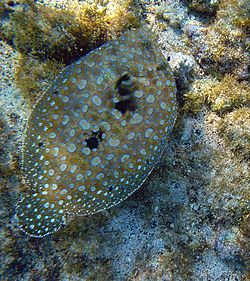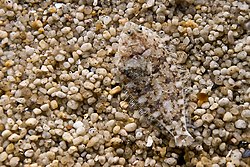
Back مفلطح Arabic Flounder English Flundro Esperanto کفشک (ماهی) Persian Flet French Leadhbóg Irish פיונית (דג) HE Ikan sebelah ID Flundro IO Flądra Polish

Bahía de la Chiva, at Hawaii

Flounders are a group of flatfish. The term is used for a number of flatfish who only related by being in the suborder Pleuronectoidei: (families Achiropsettidae, Bothidae, Pleuronectidae, Paralichthyidae, and Samaridae). It is a "form name", which means they are not necessarily close relations, they just look alike.
Flounders live at the bottom of coastal lagoons and estuaries of the Northern Atlantic and Pacific Oceans. When flounder are hatched they have one eye on each side of its head. As they grow one eye moves until they have both eyes on the same side of the head.
Industrial overfishing has reduced the population to one-tenth of its original size, and the individuals left are smaller. They rarely have the time to grow to full size.[1][2][3][4]
- ↑ Clover, Charles (2008). The end of the line: how overfishing is changing the world and what we eat. University of California Press. ISBN 978-0-520-25505-0. OCLC 67383509.
- ↑ Myers, R.A.; Worm, B. (2003). "Rapid worldwide depletion of predatory fish communities". Nature. 423 (6937): 280–283. Bibcode:2003Natur.423..280M. doi:10.1038/nature01610. PMID 12748640. S2CID 2392394.
- ↑ Dalton, Rex (2006). "Save the big fish: targeting of larger fish makes populations prone to collapse". BioEd Online. Archived from the original on 27 March 2017. Retrieved 26 March 2017.
- ↑ Hsieh, Chih-hao; Reiss, Christian S.; Hunter, John R.; Beddington, John R.; May, Robert M.; Sugihara, George (2006). "Fishing elevates variability in the abundance of exploited species". Nature. 443 (7113): 859–62. Bibcode:2006Natur.443..859H. doi:10.1038/nature05232. PMID 17051218. S2CID 4398663.